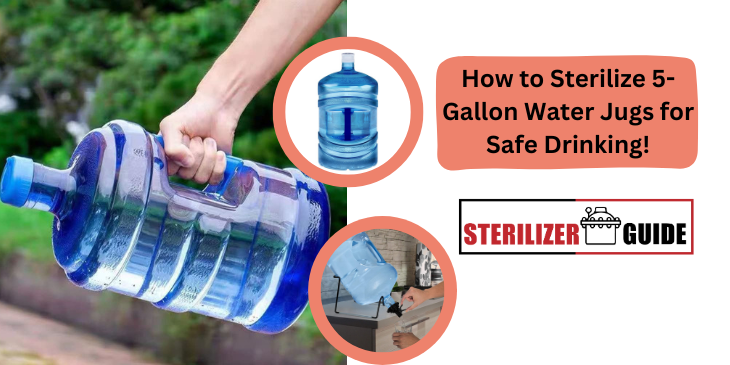If you use 5-gallon water jugs to store drinking water at home, you are aware of how crucial it is to keep them clean and sterile. These jugs can store a lot of water and are practical and portable. Over time, these jugs can accumulate bacteria and other harmful substances that can make you sick.
However, it’s important to keep these jugs clean to prevent the growth of harmful bacteria or other contaminants. In this guide, we will walk you through the process of sterilizing your 5-gallon water jugs so that you can keep your water supply safe and clean.
Why Water Jugs Needed to be Sterilized?
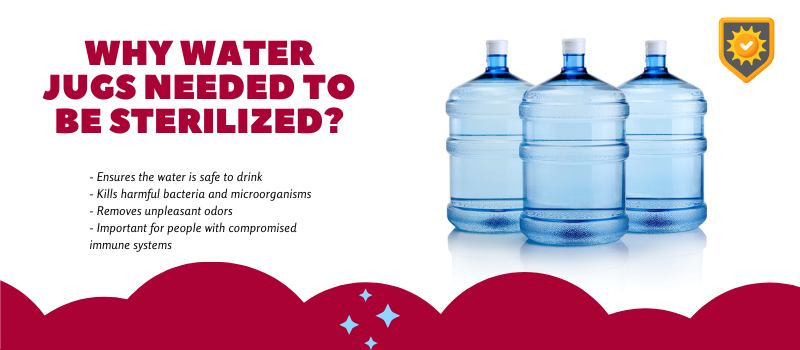
It’s crucial to comprehend why sterilizing 5-gallon water jugs is vital before beginning the procedure. In particular, if they are not frequently cleaned and sanitized, water jugs can serve as a breeding ground for bacteria and other microbes. Injurious microorganisms that can cause disorders including diarrhea, nausea, and vomiting may proliferate as a result of this.
Materials Needed to Sterilize 5-Gallon Water Jugs
To sterilize a 5-gallon water jug, you will need the following materials:
- Dish soap
- White vinegar
- Bleach
- Clean water
- Large container or bathtub
Steps to Sterilize 5-Gallon Water Jugs
Sterilizing water jugs and plastic bottles may seem like a difficult process, but it’s really not that difficult. Now that you have the required supplies, let’s take a look at the steps to properly sterilize a 5-gallon water jug:
Sterilizing 5-Gallon Water Jugs with Boiling Water

While there are many ways to sterilize water jugs, boiling water is a simple and efficient option. The natural and efficient method of getting rid of bacteria and other toxins that can be in your water jug is to boil the water. And the best part is that it’s really easy to do!
Step 1: Start by giving the 5-gallon water jug a good scrubbing in hot, soapy water. To make sure all soap residue is gone, give the jug several rinses.
Step 2: Pour enough water into a big pot to completely cover the water jug. Bring the water to a boil.
Step 3: Once the water has reached a rolling boil, carefully lower the water jug into the pot, making sure it is completely submerged.
Step 4: Boil the jug in the water for a minimum of 10 minutes. This will provide the heat sufficient time to eradicate harmful bacteria or contaminants that may be present.
Step 5: Carefully remove the jug from the boiling water and set it on a clean, dry surface using tongs or another heat-resistant utensil.
Step 6: Before using the jug, let it cool fully. It can be filled with filtered, pure water once it has cooled.
Working with boiling water requires caution to prevent burns or other harm. To prevent inhaling steam, use heat-resistant instruments and work in a well-ventilated location. After sterilizing the jug, make sure to completely rinse it with clean water to get rid of any impurities or residue that could have remained.
Sterilizing 5-Gallon Water Jugs with Vinegar
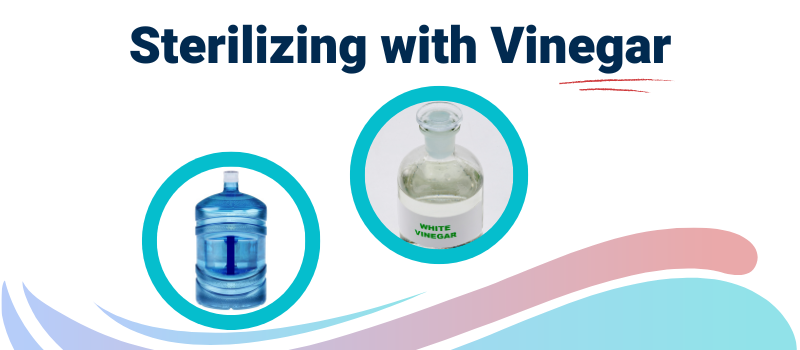
Although vinegar is a common household cleaner, it is ineffective for sterilization. A water jug can be cleaned with vinegar to get rid of dirt, stains, and odors. But vinegar lacks the strength to get rid of dangerous germs and other impurities.
Step 1: Empty and Clean the Jug
Start by draining the jug of any remaining water. After that, wash the jug in hot water and dish soap to get rid of any dirt or debris. Cleanly rinse the jug several times in clean water, then let it air dry.
Step 2: Add Vinegar
When the jug is dry, fill it about a quarter of the way with a mixture of half white vinegar and half water. Any remaining bacteria or other microorganisms will be killed by doing this.
Step 3: Swirl and Soak
The vinegar solution should be swirled around the jug to ensure that it coats every surface. The jug should soak for at least 30 minutes after that. By doing so, the vinegar solution will have more time to permeate and eradicate any leftover bacteria.
Step 4: Rinse and Dry
After the jug has soaked, drain the vinegar mixture from it and give it a good rinsing with fresh water. To make sure that all of the vinegar has been washed out, make sure to rinse the jug at least three times. Finally, let the jug completely dry by air.
Although a 5-gallon water jug can be cleaned with vinegar. It’s crucial to remember that vinegar is not an effective sterilizer. This means that while it can aid in cleaning the jug of dirt, stains, and odors. It might not be enough to eradicate dangerous germs or other bacteria.
Sterilizing 5-Gallon Water Jugs with Bleach Solution
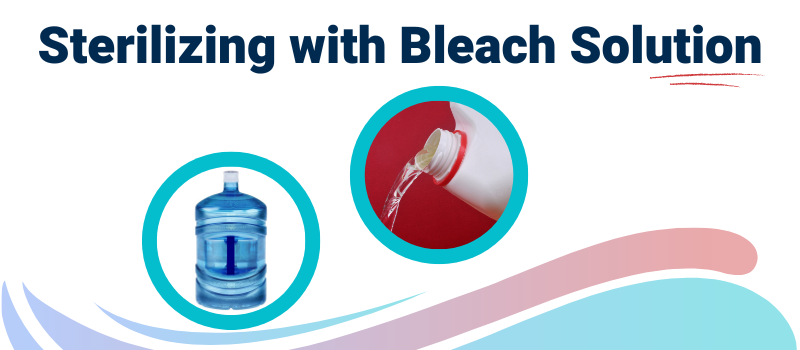
One of the most popular and efficient methods for sterilizing 5-gallon water jugs is a bleach solution. To properly sterilize a 5-gallon water container using a bleach solution, follow these steps:
Step 1: Bleach Solution
Use a bleach solution to further sanitize the jug if you want to take further security measures. Fill the jug approximately one-fourth of the way with the bleach solution after combining one teaspoon of bleach with one gallon of water. Allow the mixture to sit in the jug for at least 30 minutes after thoroughly swirling it to ensure that all surfaces are covered.
Step 2: Rinse and Dry
Pour the bleach solution out after the jug has soaked in it, and then thoroughly rinse it with clean water.
To ensure that all of the bleach has been eliminated, make sure to rinse the jug at least three times. Finally, allow the jug to air dry completely.
It’s crucial to carefully follow these instructions to guarantee that the water jug has been thoroughly disinfected and is secure for use as a source of drinking water. When using bleach, make sure to wear gloves and work in a well-ventilated area. You should also take care not to spill bleach on your clothing or other items of furniture as this could result in damage or discoloration.
Sterilizing 5-Gallon Water Jugs in Dishwasher
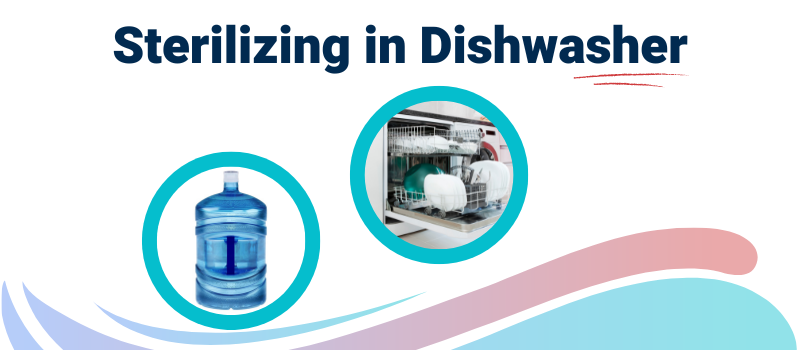
Using your dishwasher to sterilize your 5-gallon water jug can be a wonderful alternative if you’re searching for a quick and easy solution. It’s a simple process that doesn’t take any additional work from you and may efficiently get rid of any pollutants or bacteria that might be in the jug. You may carry out this quick and simple procedure whenever you need to clean your water jugs.
Step 1: Start by giving the 5-gallon water jug a good scrubbing in hot, soapy water. To make sure all soap residue is gone, give the jug several rinses.
Step 2: Make sure the water jug is solid and won’t topple over before placing it upside down on the bottom rack of your dishwasher.
Step 3: Fill the dispenser with dishwasher detergent and turn the heat dial all the way up.
Step 4: Fill the dishwasher’s bottom with a cup of white vinegar. Any bacteria or other pollutants that could be in the jug will be helped to destroy by the vinegar.
Step 5: Start the dishwasher and let it run through a full cycle. Open the dishwasher after the cycle has ended, then take care to remove the jug.
Step 6: The jug should be completely cool before use. It can be filled with filtered, pure water once it has cooled.
In order to fully sterilize the water jug, a dishwasher must have a sanitize cycle, which not all dishwashers do. If your dishwasher does not include a sanitizing cycle, you might want to think about using an alternative technique to sterilize your water jugs, such as boiling water or a bleach solution. After sterilizing the jug, make sure to completely rinse it with clean water to get rid of any impurities or residue that could have remained.
Tips for Proper Storing Water Jugs
After thoroughly sterilizing your 5-gallon water jug, it’s crucial to keep it carefully to avoid contamination. Here are some pointers for sensible storage:
- Keep the jug out of direct sunlight in a cool, dry location.
- Keep the jug away from chemicals and other potentially toxic items.
- Make sure the cap is properly secured to keep dirt and debris out.
- To ensure that the water is clean and fresh, use it within a month.
You may also read: How to Sterilize Jars for Pickles? Quick and Easy Guide
Wrapping Up!
That’s it! I’m done now! You now have access to a variety of techniques for sterilizing your 5-gallon water jug at home, ensuring that you always have clean, safe drinking water available. The most important thing is to regularly clean and sanitize your water jug completely, whether you opt to use vinegar, bleach, boiling water, or your dishwasher.
Remember, using a contaminated water jug can lead to health problems. So it’s important to take the necessary steps to ensure that your water is free of harmful bacteria and other contaminants. You may feel assured that you’re taking the proper actions to keep your water jug clean and your drinking water safe according to the instructions we’ve provided in this article.
FAQs
A sterilized water jug should be used at least once every few weeks or if there are any indications of contamination. If you frequently use your jug, you might wish to sanitize it more frequently to keep it clean and safe.
Yes, sanitizing your water jug with hydrogen peroxide can be both efficient and secure. Just be sure to adequately dilute it and then thoroughly rinse the jug.
As long as you use the proper dilution ratio and thoroughly rinse the water jug afterward, bleach can be an efficient and secure approach for sterilizing your water jug.
Since the vinegar solution might degrade over time, it’s preferable to use a fresh one every time you disinfect your water jug.
Although sterilizing your water jug in the microwave is possible, it is not advised because the jug might not be able to handle the high heat and pressure. For optimum results, stick with one of the strategies described in this guide.

